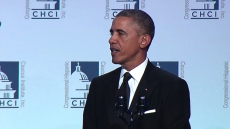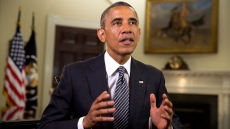Continuing to Strengthen Border Security
"We strengthened security at the borders so that we could finally stem the tide of illegal immigrants. We put more boots on the ground on the southern border than at any time
in our history. And today, illegal crossings are down nearly 80 percent from their peak in 2000."
President Obama, January 29, 2013
The President's Proposal
President Obama has doubled the number of Border Patrol agents and today border security is stronger than it has ever been. But there is more work to do. The President’s proposal gives law enforcement the tools they need to make our communities safer from crime. And by enhancing our infrastructure and technology, the President’s proposal continues to strengthen our ability to remove criminals and apprehend and prosecute threats to our national security.
![]()
Strengthen border security and infrastructure.
The President’s proposal strengthens and improves infrastructure at ports of entry, facilitates public-private partnerships aimed at increasing investment in foreign visitor processing, and continues supporting the use of technologies that help to secure the land and maritime borders of the United States.
Combat transnational crime.
The President’s proposal creates new criminal penalties dedicated to combating transnational criminal organizations that traffic in drugs, weapons, and money, and that smuggle people across the borders. It also expands the scope of current law to allow for the forfeiture of these organizations’ criminal tools and proceeds. Through this approach, we will bolster our efforts to deprive criminal enterprises, including those operating along the Southwest border, of their infrastructure and profits.
![]()
Improve partnerships with border communities and law enforcement.
The President’s proposal expands our ability to work with our cross-border law enforcement partners. Community trust and cooperation are key to effective law enforcement. To this end, the U.S. Department of Homeland Security (DHS) will establish border community liaisons along the Southern and Northern borders to improve communication and collaboration with border communities, boost funding to tribal government partners to reduce illegal activity on tribal lands, and strengthen training on civil rights and civil liberties for DHS immigration officers.
Crack down on criminal networks engaging in passport and visa fraud and human smuggling.
The President’s proposal creates tough criminal penalties for trafficking in passports and immigration documents and schemes to defraud, including those who prey on vulnerable immigrants through notario fraud. It also strengthens penalties to combat human smuggling rings.
Progress Strengthening Border Security
![]()
Doubling boots on the ground.
Today, the Border Patrol is better staffed than ever before, having doubled the number of agents from approximately 10,000 in 2004 to more than 21,000 in 2011. More than 2,200 Border Patrol agents man the Northern border, a 700 percent increase since 9/11. More than 21,000 Customs and Border Protection Officers, including 3,800 along Northern Border, manage the flow of people and goods at our ports of entry and crossings.
Stepping up surveillance.
For the first time, DHS unmanned aerial capabilities now cover the entire Southwest border, from California to Texas, providing critical aerial surveillance assistance to personnel on the ground. DHS has also completed 649 miles of fencing out of nearly 652 miles planned.
![]()
Enhancing investigative resources.
Immigration and Customs Enforcement (ICE), the investigative arm of DHS, has increased the number of Federal agents deployed on the Southwest border. These additional personnel are working alongside the Department of Justice (DOJ) to identify, disrupt, and dismantle criminal organizations, to facilitate cooperation between U.S. and Mexican law enforcement authorities on investigations and enforcement operations, and to track and prevent cartel violence.
Fewer people attempting to illegally cross our borders.
Apprehensions decreased from nearly 724,000 in FY 2008 to approximately 340,000 in FY 2011, a 53 percent reduction, indicating that fewer people are attempting to illegally cross the border.
Fighting transnational criminal organizations.
The Administration is working with the Government of Mexico and others to disrupt the transnational criminal organizations that traffic illicit drugs, weapons, and bulk cash, and the interdiction of illicit weapons. These unparalleled efforts have yielded real results. Over the past two and a half years, DHS seized 75 percent more currency, 31 percent more drugs, and 64 percent more weapons along the Southwest border compared to two and a half years of the previous administration.
Making border cities among the safest in the country.
Crime rates in border communities including Nogales, Douglas, Yuma and other Arizona border towns have either remained flat or fallen in the past decade, even as drug-related violence has dramatically increased in Mexico. According to FBI Crime Index Statistics, the top four big cities in America with the lowest rates of violent crime are all in border states—San Diego, Phoenix, El Paso, and Austin.
![]()
Working with Mexico.
Through the Twenty-First Century Border Initiative, the United States is partnering with the Government of Mexico to improve coordination in planning, financing, building, and operating bi-national infrastructure; to enhance cross-border commerce and ties while managing our common threats; and to augment law enforcement cooperation to disrupt “criminal flows” and enhance public safety.
![]()
Working with Canada.
The Administration is working with Canada to enhance joint law enforcement efforts and bolster cross-border security operations. Through the United States – Canada Beyond the Border Action Plan, Canadian and U.S. law enforcement are forging new ways of sharing resources, personnel, and information to uncover and disrupt threats that endanger the security of both the United States and Canada.
Making improvements to the northern border infrastructure.
We are modernizing more than 35 land ports of entry to meet our security and operational needs. We have also deployed new technology, including thermal camera systems, mobile surveillance systems, and remote video surveillance systems.
Promoting economic prosperity along the border.
In 2011, two-way trade in goods and services between the U.S. and Mexico exceeded a staggering half trillion dollars. U.S. exports to Mexico totaled close to $200 billion, exceeding our exports to Brazil, Russia, India, and China combined. The Obama Administration is working to ensure that legal trade and travel flows across our borders as quickly as possible by updating infrastructure, reducing wait times, and increasing security. In 2011, the Obama Administration launched the Border Export Strategy to highlight the significance of the U.S.-Mexico trade relationship and, more specifically, the vibrant, diverse, and talented communities that make up the border region.
![]()
Increasing community outreach.
Customs and Border Protection (CBP) has created the Office of the Non-Governmental Organization Liaison in the Commissioner’s Office, which works closely with CBP to educate the traveling public and stakeholders. Additionally, CBP implemented a national Border Community Liaison Program in each of the 20 Border Patrol Sectors and the Border Patrol Academy for community members to learn more about the Border Patrol. These liaisons focus primarily on outreach with community groups and help law enforcement under¬stand the views and concerns of individuals living in border towns.
 Our journey is not complete until we find a better way to welcome the striving, hopeful immigrants who still see America as a land of opportunity; until bright young students and engineers are enlisted in our workforce rather than expelled from our country.
Our journey is not complete until we find a better way to welcome the striving, hopeful immigrants who still see America as a land of opportunity; until bright young students and engineers are enlisted in our workforce rather than expelled from our country.

President Barack Obama
January 21, 2013

